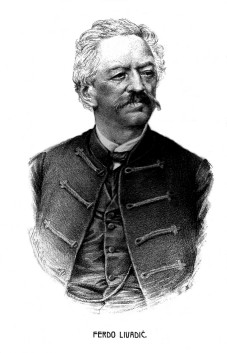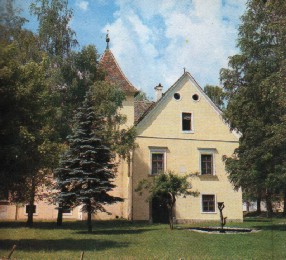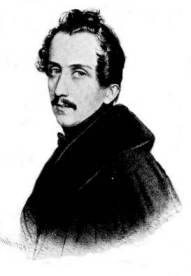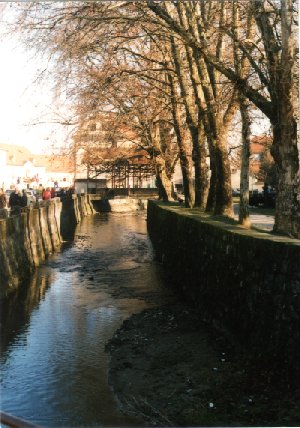
(1799 - 1879)

Ferdo LivadiŠ (Wiesner) was the first modern Croatian composer, the founder of the national style in Croatian music, and one of the leaders of The Illyrian Movement, that is The Croatian National Revival.
He was born on May 30, 1799, in Celje (today The Republic of Slovenia). His father was a court assessor. In 1809 Ferdo inherited from his aunt an estate in Samobor and the family moved there. In Samobor Ferdo LivadiŠ finished primary school and continued his education in Zagreb. His first musical education he acqiured in Samobor school, where his teacher was Josip HeroviŠ, the founder of the Samobor brass orchestra (1807). In Zagreb he continued to study music, especially singing and violin.

Samobor (watercolor, around 1810) - in the middle The LivadiŠ Estate In 1815. his father sent him to Graz (Austria) to study law. At the same time he studied music by the well known composer Anselmo HŘttenbrenner, the friend of Beethoven and Schubert. Soon he became known in Graz as a violinist, pianist and a composer and Steyr Music Society made him a honorary member. After his law degree in 1822 he wanted to go to Vienna to get his doctorate and continue his musical education. But, when he turned 24, his father had, as was stated in his aunt's will, handed him over the estate. He had to return to Samobor and take care of the estate.He got married in Graz on February 24, 1823, with Katarina Presinger.

The LivadiŠ Mansion - today The Samobor Museum He dwelled in his mansion for full 56 years, being the host to three generations of Croatian politicians, writers, poets and composers.His home was the center of The Illyrian Movement and The Croatian National Revival. He studied and collected the folk music heritage and later used it in his compositions. He wrote in his home on one winter evening in 1833 the music for the first and most famous Croatian patriotic song "Croatia Hasn't Perished Yet", writen by his friend and the leader of The Illyrian Movement, Ljudevit Gaj. As Gaj himself has told, on the early 1833 winter evening he was riding on a sleigh to LivadiŠ in Samobor. Amazed with the beauty of the winter scenery and with the peasant music heard from the nearby village, he started to make rhymes. Arriving at the LivadiŠ home, he rushed up the stairs, asked for some paper and noted down the poem. LivadiŠ sat at his piano and to Gaj's humming wrote the music in folk rhythm.

Ljudevit GajThis song was the first Croatian awakening song and soon became a kind of hymn of The Illiryan Movement. it was performed for the first time in public as an intermezzo in The Zagreb Theater during the performance of Josef Schweigert's play "Die Magdalenen Grotte bei Ogulin" (in German). The arrangement for the choir and orchestra was written by the conductor Juraj Wisner von Morgenstern. Sung in Croatian, the song received standing ovations, was repeated ten times and was regularly performed later at reruns of the play.
Ferdo LivadiŠ arranged the song for the voice and the piano for the first public performance of the 16 year old Countess Sidonia Erd÷dy in March of 1835.She later sung many works of Illiryan composers.

The LivadiŠ piano, made by Aloys Graff, Vienna, around 1830 - today in The Samobor MuseumIn his mansion LivadiŠ hosted all the important persons and leaders of The Illiryan Movement. His regular guests were, beside Gaj, Ljudevit VukotinoviŠ (LivadiŠ wrote music for his poem "The OkiŠ Crows"), Dragutin Rakovac, Petar PreradoviŠ, Stanko Vraz (who has, during his visit to Samobor, fallen in love with beautiful Gaj's niece Ljubica Juliana Cantilly and he later dedicated his book of poems "Gjulabije"/"The Red Apples"/ to her), Vatroslav Lisinski (author of the first Croatian opera "Love and Malice") and many others.
LivadiŠ received many foreign artists, such as Willmers, Julius Epstein, Leopold Zellner, GrŘn, StaziŠ-St÷ger, Zadrobilkov, Cecilia Frank...
His guest was also the famous Franz Liszt during his visit to Zagreb in 1846, and he even played on LivadiŠ's piano.
Ferdo LivadiŠ has composed his music for more than 40 years.His opus includes some 140 Croatian songs, a dozen in Slovenian. 45 in German, 32 sacral pieces, 40 piano marches, 20 dances and some 20 various other pieces. With his work he paved the road for the Croatian national music of Vatroslav Lisinski and Ivan Zajc. LivadiŠ took an active part in the social and political life of Samobor. In one term he was the deputy mayor (1838-1841) and for two terms he occupied the mayor's seat (1842-1845 and 1847-1850). For three years (1847-1850) he was also the principal of the Samobor school. He died in his home on January 8, 1879 and was buried in Samobor cemetery. On his grave and in front of his house is his bust, the work of the Samobor sculptor Ferko IvanÜŔak. In the year 1902 a memory bas-relief was set on the Samobor Magistrate building, the work of sculptor Rudolf Valdec.
Today his name bears the street by his mansion, the Samobor tamburitzans society and the primary music school in Samobor.
This year 200 anniversary of his birth and 120 years of his death will be marked.

LivadiŠeva Street